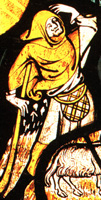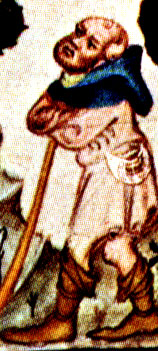

Main Menu - Misc. - Clothing/Textiles - Medieval Wales - Names - Other Medieval - Publications - Harpy Publications
Return to main page


Any time you research a topic primarily in the context of art -- especially in the context of symbolic or allegorical art -- at some point you need to ask yourself, "Is this object a reflection of an artifact in the artist's contemporary experience, or is it a conventional artistic motif that has meaning, but no substance?" This is a question that I've considered very seriously in the context of Shepherds Purses, both because of the particular distrubution of the images, and because of the lack of concrete artifacts to compare them to. Clothing topics are particularly prone to this issue, given that only a fraction of historic styles have a surviving representative preserved. Complicating the issue is the question, "what historic context are we applying the question to?" For example, medieval illustrations of Old Testament scenes frequently show male figures wearing a curious broad conical hat. Is this an actual artifact -- and is it an artifact of Biblical times or of medieval times? One can pretty easily rule out the possibility that medieval artists were depicting a hat style of ancient Jewish culture -- the medieval concept of "ancient dress" was nowhere near that nuanced, and was restricted primarily to a notion that "pre-contemporary" peoples may have worn somewhat archaic styles -- but "archaic" pretty much limited itself to the looser, simpler, drapier styles of the early Christian era that they might have access to via sculpture, mosaic, and similar survivals. More typically, such "archaic" styles were more a signifier of artistic focus or religious significance -- ordinary people were depicted in clothing contemporary to the artist. But this, in turn, supports the idea that this curious conical hat may have had some contemporary reality for the artists, applied retroactively to Old Testament figures. And, in fact, one can find significant amounts of supporting evidence for an medieval object known as a "Jewish hat" that, in some cultures, Jews were required to wear in public as a label of their cultural identity. But that doesn't mean that the "Jewish hat" was in common use in every culture that produced artwork incorporating it as an iconic signifier. It could, reasonably, have spread from artistic contexts where it represented the contemporary reality of Jewish costume to contexts where the artists simply understood it as an indication that the figure depicted was Jewish.
The topic is tricky, and in any given situation, the answer may be a complicated mixture of both "artifact" and "artistic motif". I'll take both positions, in turn, marshalling the best arguments I can think of for each position, and then attempt to reconcile and answer the questions that each position raises.
The detail with which the Shepherds Purses are shown in many cases argues for an existing artist's model. The range of variations in detail (leaving aside the examples that are not shown in detail) also argue for working from life. Features such as netting seem awfully odd as pure invention. While I believe there is a clear stylistic group under the "Shepherds Purse" label, that group merges at the edges with other styles that could not be considered to have an iconic function (or at least, not the same iconic function). When the pouches are shown in enough detail to interpret the construction, it is a plausible construction and behaves in the desired ways. There are plausible reasons why a particular functional style of pouch might be associated specifically with shepherds and those with similar needs -- and the fact that we also see the style on those with related occupations (i.e., swineherds) is also evidence that the association with shepherds is not arbitrary. Artificial iconic labels come into use when a clear identification is desired and there isn't one already available -- for example, the "Jewish hat" is used iconically because there wasn't necessarily a more obvious visual distinguisher of Jewish identity (although there is also some use of facial features for this purpose). For example, angels, having wings to identify them, typically appear otherwise as ordinary human beings -- while other features may appear in connection with angels, they tend not to develop into iconic markers because the wings serve that purpose already. Since there are much more obvious indicators of a shepherd's profession (and any shepherd wearing a Shepherds Purse is normally accompanied by one or more of these), it makes no sense that this style of pouch would be invented for the purpose of marking a shepherd's occupation.
Most styles of pouch, even when closely associated with a particular class or occupation, occur much more broadly in distribution. For example, the "pilgrim's bag" is seen used by travelers of all types, the "kidney-shaped" pouch may be loosely associated with upper-class figures, but is seen regularly on all classes. The supposed "Shepherds Purse" group is not actually a natural grouping at all, since it includes wildly different object-structures. It would make perfect sense if the nucleus were an abstract idea of a vaguely crescent-shaped object, and different "schools" of artists interpreted this shape in terms of different details. Notice that large numbers of the pouches are not depicted in detail at all. Even the apparent evolution in style over time may be a product of clumps of data from the same industry and/or school. For example, particular features are associated with the Shepherds Purses depicted in early 16th century tapestries (e.g., tools attached to rings on the pouch flap) that are distinctly different from contemporary manuscript images of the same item. Some of the depictions clearly include unlikely versions of the supposed core chracteristics. For example, depictions of the netted crescent style of bag with the meshes set square-wise seem to me to represent an impractical construction. And the depiction of a net-like pattern on a deep flapped pouch (the stained glass annunciation) is clearly an artist's fancy.
In some ways some of the strongest arguments on the "artistic motif" side undermine themselves. The lack of homogeneity in pouch types seems better explained by a functional purpose rather than by differing artistic elaboration of a general shape. On the other hand, it is extremely likely that some of the pouch depictions involve artistic deviations from reality, even if they originate in an actual artifact. Whether particular "clumps" of sub-variants are better explained by regional variation in the artifact, or by variations promulgated by a particular artistic school may be impossible to decide (certainly without more extensive data). But looking at examples where artistic borrowing is evident (e.g. the woodcut and tapestry annunciation pair, and the matching shepherdesses in the Tres Riches Heures and Rohan Hours), we see a fair amount of variation in the details of the pouches and similar objects, so arguments that similarities are necessarily the result of copying models are weakened. On the "artifact" side, one of the strongest logical arguments is that there seems to be no reason to invent the Shepherds Pouch. It serves no artistic purpose that was not already being covered.
In all, I believe that the Shepherds Purse motif represents a style that was actually in use, although in some cases it may have acquired an additional symbolic function, as in the "noble pastoral" type of tapestry scene. Further, I believe that the variation in actual structure is a result of convergent evolution -- several styles of container being modified into a shape that was particularly convenient for the needs of a shepherd. What were those needs?
Previous --------------------------------------------- Main --------------------------------------------- Next
This site belongs to Heather Rose Jones. Contact me regarding anything beyond personal, individual use of this material.
Unless otherwise noted, all contents are copyright by Heather Rose Jones, all rights reserved.